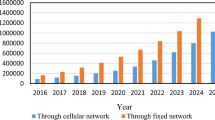Abstract
This paper presents a novel architecture of iterative receivers with two layers of iterations for turbo coded multiple-input and multiple-output orthogonal frequency-division multiplexing (MIMO-OFDM) systems, where soft messages are passed not only between the MIMO detector and the turbo decoder, but also between the two component decoders within the turbo decoder. We first derive the factor graph representation of a turbo coded system as a basic building block for developing the iterative receivers. Then, a new soft message passing schedule over the factor graph is proposed, resulting in the proposed dual-turbo receiver architecture (DTRA). In DTRA, the MIMO detector and the turbo decoder work concurrently, and the soft messages for both layers of iterations are updated instantaneously, instead of the block-based exchange of soft messages in the conventional iterative receivers. In so doing, the processing latency can be greatly reduced while low computational complexity can be achieved.
Similar content being viewed by others
References
Telatar E. Capacity of multi-antenna Gaussian channels. Euro Trans Telecomm, 1999, 10: 585–595
Paulraj A, Nabar R, Gore D. Introduction to Space-time Wireless Communications. Cambridge: Cambridge University Press, 2003
Cimini L Jr. Analysis and simulation of a digital mobile channel using orthogonal frequency division multiplexing. IEEE Trans Commun, 1985, 33: 665–675
Stuber G, Barry J, Mclaughlin S, et al. Broadband MIMO-OFDM wireless communications. Proc IEEE, 2004, 92: 271–294
Sampath H, Talwar S, Tellado J, et al. A fourth-generation MIMO-OFDM broadband wireless system: Design, performance, and field trial results. IEEE Commun Mag, 2002, 40: 143–149
Hochwald B, Brink S. Achieving near-capacity on a multiple-antenna channel. IEEE Trans Commun, 2003, 51: 389–399
Sellathurai M, Haykin S. Turbo-BLAST for wireless communications: Theory and experiments. IEEE Trans Signal Process, 2002, 50: 2538–2546
Wang D, Zhao J, Gao X, et al. Space-time turbo detection and decoding for MIMO block transmission systems. Proc IEEE Int Conf Commun, 2004, 5: 2914–2918
Kschischang F, Frey B, Loeliger H. Factor graphs and the sum-product algorithm. IEEE Trans Inf Theory, 2001, 47: 498–519
Loeliger H, Endora A, Basel S. An introduction to factor graphs. IEEE Signal Process Mag, 2004, 21: 28–41
Vikalo H, Hassibi B, Kailath T. Iterative decoding for MIMO channels via modified sphere decoding. IEEE Trans Wireless Commun, 2004, 3: 2299–2311
Robertson P, Villebrun E, Hoeher P. A comparison of optimal and sub-optimal MAP decoding algorithms operating in the log domain. Proc IEEE Int Conf Commun, 1995, 2: 1009–1013
Wang D, Gao X, You X. Low complexity turbo receiver for multi-user STBC block transmission systems. IEEE Trans Wireless Commun, 2006, 5: 2625–2632
Masera G, Piccinini G, Roch M, et al. VLSI architectures for turbo codes. IEEE Trans VLSI Syst, 1999, 7: 369–379
Studer C, Burg A, Bolcskei H. Soft-output sphere decoding: Algorithms and VLSI implementation. IEEE J Sel Areas Commun, 2008, 26: 290–300
Benedetto S, Divsalar D, Montorsi G, et al. Algorithm for continuous decoding of turbo codes. Electron Lett, 1996, 32: 314–315
International Telecommunication Union. Guidelines for evaluation of radio transmission technologies for IMT-2000. 1997
Dolinar S, Divsalar D. Weight distributions for turbo codes using random and nonrandom permutations. TDA Progress Rep, 1995, 42: 56–65
Yu X H, Chen G, Chen M, et al. Toward beyond 3G: The FuTURE project in China. IEEE Commun Mag, 2005, 43: 70–75
Tüchler M, Singer A, Koetter R. Minimum mean square error equalization using a priori information. IEEE Trans Signal Process, 2002, 50: 673–683
Ito T, Wang X, Kakura Y, et al. Performance comparison of MF and MMSE combined iterative soft interference canceller and V-BLAST technique in MIMO/OFDM systems. Proc IEEE VTC Fall, 2003, 1: 488–492
Author information
Authors and Affiliations
Corresponding authors
Rights and permissions
About this article
Cite this article
Wang, W., Gao, X., Wu, X. et al. Dual-turbo receiver architecture for turbo coded MIMO-OFDM systems. Sci. China Inf. Sci. 55, 384–395 (2012). https://doi.org/10.1007/s11432-011-4335-3
Received:
Accepted:
Published:
Issue Date:
DOI: https://doi.org/10.1007/s11432-011-4335-3




